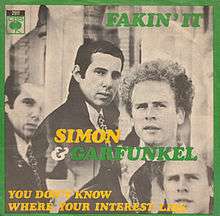Fakin' It (Simon & Garfunkel song)
| "Fakin' It" | ||||
|---|---|---|---|---|
 Netherlands cover | ||||
| Single by Simon & Garfunkel | ||||
| from the album Bookends | ||||
| B-side | "You Don't Know Where Your Interest Lies" | |||
| Released | July 7, 1967 | |||
| Format | 7" single | |||
| Recorded |
June 1967 Columbia Studio A (New York City) | |||
| Genre | ||||
| Length | 3:14 | |||
| Label | Columbia | |||
| Writer(s) | Paul Simon | |||
| Producer(s) | ||||
| Simon & Garfunkel singles chronology | ||||
| ||||
"Fakin' It" is a song recorded by American music duo Simon & Garfunkel for their fourth studio album, Bookends (1968). The song was initially released only as a single on July 7, 1967 through Columbia Records. It was later compiled into the second half of Bookends. The song's lyrics stem from Simon wondering about his occupation and life had he been born a century earlier.
The song was a minor hit in the United States, peaking at number 23 on the Billboard Hot 100.
Background
Shortly before production began in earnest on Simon & Garfunkel's fourth LP, Bookends, Paul Simon hit a dry spell in his writing.[1] Amid concerns for Simon's idleness, Columbia Records chairman Clive Davis arranged for up-and-coming record producer John Simon to kick-start the recording.[2]
His first session with the group was for "Fakin' It" in June 1967.[3] The duo were signed under an older contract that specified the label pay for sessions ("As a folk duo, how much could recording costs be?" said John Simon).[3] Simon & Garfunkel took advantage of this indulgence, hiring viola and brass players, as well as percussionists.[4] When the viola players arrived, the duo were so taken with the sound of the musicians tuning their instruments before recording that they spent nearly all night (at Columbia's expense) trying to find the random sound.[4]
Composition
 |
"Fakin' It"
The song contains a brief detour into spoken word before returning to music. |
| Problems playing this file? See media help. | |
In "Fakin' It", melodies are occasionally deleted to suit lyrics, but the song generally follows a similar chord structure and melodic outline over a "funky rock beat" that sonically references the Beatles' "Tomorrow Never Knows".[5] The song opens with an "unearthly rhythmic sound" (that some critics felt owed a debt to the Beatles' "Strawberry Fields Forever") that was an example of Simon & Garfunkel's desire to push the limits of studio recording.[6] The song finds the protagonist mulling over his insecurities and shortcomings.[7] It has been suggested that "Fakin' It" may be an allegory for Simon's relationship with Art Garfunkel.[8]
Near the middle of the song is a brief spoken word vignette featuring a British woman entering a tailor shop and greeting the owner: "Good morning, Mr. Leitch. Have you had a busy day?"[6] The woman performing was singer Beverley Martyn, who was friends with singer-songwriter Donovan. Donovan's last name was Leitch, hence the name's use in the song.[6] Simon knew Martyn from his days living in England, and she was often around the duo's friend circle at the time of recording.[9]
The lines about being a tailor arose from an occasion in which Simon was wondering what his occupation would be had he been born a century earlier. "During some hashish reverie I was thinking to myself, 'I'm really in a weird position. I earn my living by writing songs and singing songs. It's only today that this could happen,'" he explained.[9] He settled on the idea that he may have been a tailor, and likely from Vienna or Hungary, as that is where his ancestors migrated from.[6] Simon's father revealed to him later that, coincidentally, his grandfather was a tailor also named Paul from Vienna.[6]
Commercial performance
"Fakin' It" was issued as a single that summer and found only modest success on AM radio; the duo were much more focused on the rising FM format, which played album cuts and treated their music with respect.[10] The running time of the song was actually 3 minutes and 14 seconds. Radio stations at the time resisted playing songs lasting longer than three minutes, so Paul Simon had the time "faked" to read 2:74 on the label. Simon preferred the album version of "Fakin' It" to its single release. He felt the stereo remix "greatly improved" the original mix, which he considered to be "sloppy."[9]
It debuted on the Billboard Hot 100 in the US at number 81 in the issue dated July 29, 1967,[11] rising over the course of five weeks to its peak of position 23 on September 2, 1967.[12] It last appeared on the chart September 16, 1967 at position 65, before dropping out.[13]
Reception
Billboard predicted it might reach the top 20 of its chart in its review, calling it an "intriguing folk rocker" and praising John Simon's "exceptional" production work.[14] Mojo called "Fakin' It" a "dope-induced contemplation on an earlier life."[15]
Charts
Weekly charts
NotesReferences
Sources
External links |